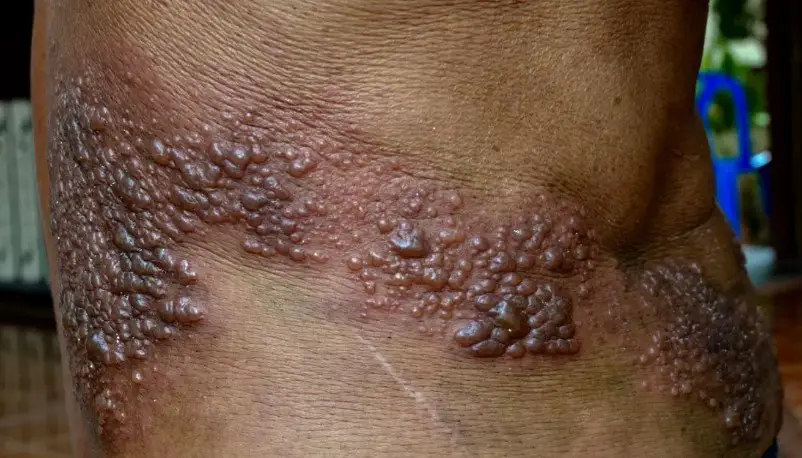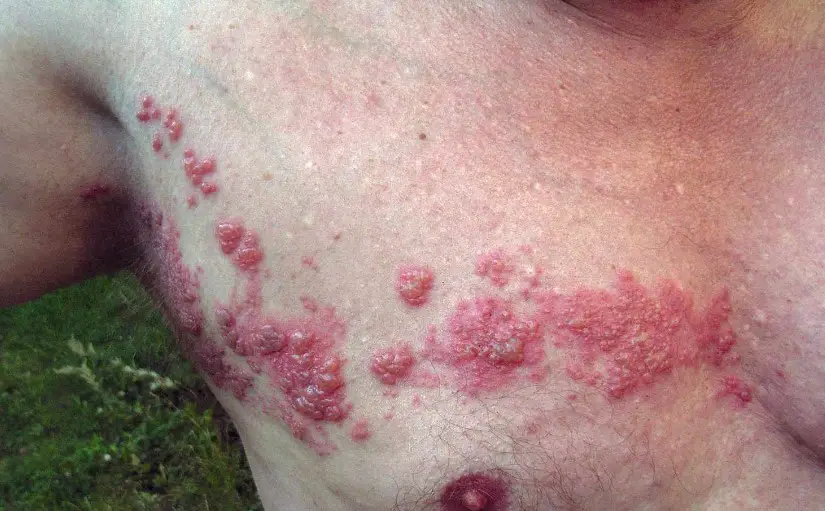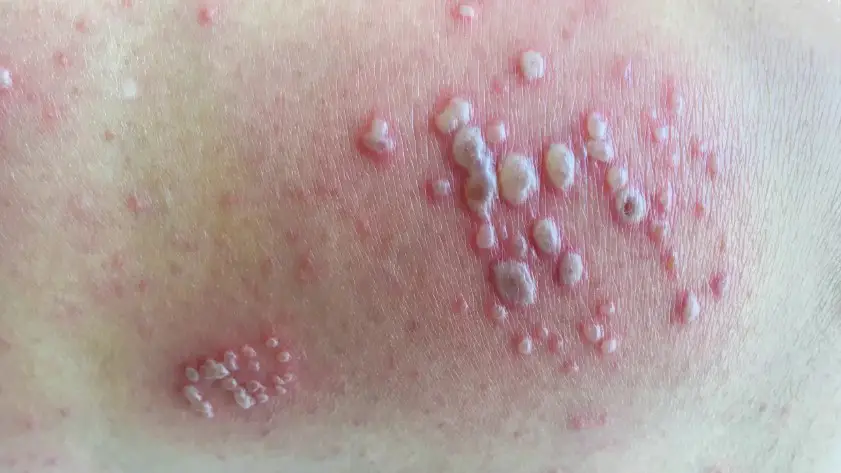Shingles and herpes, both viral infections, often stir confusion due to their shared viral nature yet distinct characteristics and impacts on health. While both conditions are rooted in the herpes virus family, they manifest differently and are caused by different viruses within this family. This initial confusion warrants a closer look into their specifics, as understanding their differences is crucial for accurate diagnosis and treatment.
Shingles, caused by the varicella-zoster virus, manifests as a painful rash typically on one side of the body or face. It is a reactivation of the chickenpox virus in people who have previously been infected. Herpes, on the other hand, refers to infections caused by herpes simplex viruses type 1 (HSV-1) or type 2 (HSV-2), leading to oral or genital sores. Despite both being part of the herpesviridae family, shingles and herpes are distinguished by their causative viruses, symptoms, and transmission routes.
The importance of distinguishing between these two lies not only in their management and treatment but also in understanding their transmission and preventive measures. While shingles is a condition primarily affecting older adults or those with weakened immune systems, herpes infections are common and can affect anyone regardless of age or health status. This distinction underscores the need for awareness and education on these conditions to ensure they are appropriately addressed.

Shingles Explained
What Is Shingles?
Shingles, medically known as herpes zoster, is a condition that results from the reactivation of the varicella-zoster virus (VZV), the same virus that causes chickenpox in childhood. After a person recovers from chickenpox, the virus remains dormant in nerve tissue near the spinal cord and brain. Years later, it can reactivate as shingles. This condition is characterized by a painful rash that usually appears as a single stripe of blisters that wraps around either the left or the right side of the torso, although it can occur anywhere on the body.
Symptoms of Shingles
The symptoms of shingles can be quite distinctive, making it easier for healthcare providers to diagnose. They include:
- Pain, burning, numbness, or tingling sensation, which typically precedes the appearance of the rash by several days.
- A red rash that begins a few days after the pain. The rash forms blisters that typically scab over in 7 to 10 days and clear up within 2 to 4 weeks.
- Itching.
- Fever, headache, fatigue, and sensitivity to light in some cases.
Shingles Transmission
Shingles cannot be passed from one person to another. However, the varicella-zoster virus can be spread from a person with active shingles to someone who has never had chickenpox or the chickenpox vaccine. This transmission can only occur through direct contact with the open sores of the shingles rash. Once infected, the individual will develop chickenpox, not shingles. Immunocompromised individuals and elderly are particularly at risk for more severe manifestations of shingles.
Herpes Simplified
What Is Herpes?
Herpes refers to a group of viruses known as the herpesviridae family, which includes more than eight viruses. The most common types are herpes simplex virus type 1 (HSV-1), commonly associated with oral herpes (cold sores), and herpes simplex virus type 2 (HSV-2), which typically causes genital herpes. These viruses can cause recurrent episodes of sores and blisters.
Symptoms of Herpes
Symptoms of herpes can vary widely among individuals and include:
- Cold sores or fever blisters on the lips or around the mouth for HSV-1.
- Painful blisters or ulcers on the genital or rectal area for HSV-2.
- Itching or tingling around the affected area before the blisters appear.
- During the initial outbreak, flu-like symptoms such as fever, body aches, and swollen lymph nodes may occur.
Herpes Transmission
Herpes is highly contagious and can be transmitted through direct contact with an infected person’s skin or mucous membranes. HSV-1 is commonly spread by kissing or sharing objects like toothbrushes or eating utensils, while HSV-2 is primarily spread through sexual contact. Even without visible sores, herpes can be transmitted from an infected person to their sexual partner.
Key Differences
Virus Comparison
Shingles is caused by the varicella-zoster virus (VZV), which also causes chickenpox. In contrast, herpes is caused by the herpes simplex virus (HSV), with two main types affecting different parts of the body. These viruses belong to the same family but are different strains, each responsible for their distinct conditions.
Symptom Contrast
Shingles typically presents a painful rash that may wrap around one side of the torso, while herpes causes cold sores or genital blisters. Shingles can also lead to complications like postherpetic neuralgia (PHN), where pain lasts long after the rash has cleared. Herpes, on the other hand, tends to recur, especially when triggered by stress, sunlight, or a weakened immune system.
Transmission Divergence
Shingles cannot be directly transmitted from person to person to cause shingles. Instead, a person with active shingles can spread VZV, leading to chickenpox in someone who has never been infected or vaccinated. Herpes spreads through direct contact with an infected individual, even if sores are not present, which differentiates it significantly from how shingles is transmitted.

Diagnosis and Treatment
Diagnosing Shingles and Herpes
Diagnosing both shingles and herpes typically begins with a healthcare provider conducting a visual inspection of the symptoms. The characteristic rashes and blisters often provide clear indicators, but to confirm the diagnosis, particularly in unclear cases, medical tests may be necessary.
- Tissue scraping or culture of the blister fluid can help identify the virus responsible for the condition.
- Blood tests might detect the presence of antibodies against the varicella-zoster virus or herpes simplex virus, indicating a current or past infection.
Treatment Options
For both shingles and herpes, treatment focuses on reducing symptoms, shortening the duration of the outbreak, and minimizing complications.
Shingles
- Antiviral medications such as acyclovir, valacyclovir, and famciclovir are most effective when started within 72 hours of the appearance of the rash.
- Pain relief can be managed with over-the-counter pain medications, numbing agents, or corticosteroids in severe cases.
- Rest and stress management are crucial to help the body fight the infection.
Herpes
- Treatment includes antiviral drugs like acyclovir, famciclovir, and valacyclovir to help reduce the severity and frequency of outbreaks.
- Pain relief methods and topical creams may help alleviate symptoms during outbreaks.
- Daily suppressive therapy may be recommended for individuals with frequent outbreaks to reduce transmission risk.
Prevention Strategies
Vaccines and Immunity
Shingles
- The shingles vaccine is highly recommended for older adults, typically those over 50 or 60, to prevent the onset of shingles or lessen its severity. The current vaccine, Shingrix, has shown to be over 90% effective.
Herpes
- There is no vaccine available for herpes simplex virus, but ongoing research aims to develop one. Preventing HSV transmission relies on avoiding direct contact with sores, using barrier methods during sexual activity, and not sharing items that come into contact with the mouth or genitals.
Lifestyle and Precautions
General Precautions
- Hand hygiene is crucial in preventing the spread of viruses.
- Safe sex practices, including the use of condoms, can significantly reduce the risk of genital herpes transmission.
- Avoiding contact with the sores or rashes of infected individuals.
Impact on Quality of Life
Emotional and Physical Impact
Living with shingles or herpes can have significant emotional and physical impacts. The pain and discomfort associated with outbreaks can affect daily activities, while the stigma attached to herpes can lead to social isolation, anxiety, and depression.
Managing Chronic Symptoms
Managing chronic symptoms involves a combination of medical treatment, lifestyle adjustments, and support:
- Regular physical activity and a healthy diet can strengthen the immune system.
- Stress management techniques, such as meditation, yoga, or therapy, can help cope with the emotional toll of chronic conditions.
- Joining support groups can provide a sense of community and reduce feelings of isolation.
Frequently Asked Questions
What triggers a shingles outbreak?
A shingles outbreak is often triggered by stress, a weakened immune system, or age-related immune decline. The varicella-zoster virus, which remains dormant in nerve tissue after chickenpox, reactivates to cause shingles. Factors such as illness, stress, and certain medications can weaken the immune system, making it easier for the virus to reactivate.
Can herpes be cured?
Currently, there is no cure for herpes infections caused by HSV-1 and HSV-2. However, antiviral medications can manage outbreaks, reduce symptoms, and decrease the risk of transmission to others. Although these treatments help control herpes, they do not eliminate the virus from the body.
Is it possible to have both shingles and herpes?
Yes, it is possible to have both shingles and herpes, as they are caused by different viruses within the same family. An individual can experience shingles if they have had chickenpox in the past and can also contract herpes simplex virus leading to oral or genital herpes, independently of the shingles infection.
How can I prevent shingles and herpes?
Preventing shingles is possible with the shingles vaccine, recommended for adults over 50 and those with weakened immune systems. Preventing herpes involves avoiding direct contact with the sores of an infected person, using barrier methods during sexual activity, and not sharing items that have come into contact with the virus.
Conclusion
Understanding the differences between shingles and herpes is essential for proper diagnosis, treatment, and prevention. While they share similarities, such as their viral nature and capacity to cause significant discomfort, their distinctions in causative viruses, symptomatology, and management strategies are crucial. Recognizing these differences enables individuals to seek appropriate care and take preventive measures against these infections.
The awareness and education surrounding shingles and herpes can empower individuals to better manage their health, minimize transmission, and improve their quality of life. Through informed discussions and medical advice, those affected by either condition can navigate their symptoms with greater confidence and understanding, ultimately leading to more effective and targeted treatment approaches.

